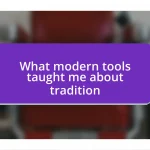Key takeaways:
- Effective cross-department collaboration hinges on clear communication, understanding diverse goals, and fostering an inclusive environment.
- Utilizing dedicated tools and regular check-ins significantly enhances teamwork, trust, and alignment among departments.
- Celebrating collaborative achievements boosts morale, inspires future cooperation, and cultivates a culture of recognition and shared purpose.

Understanding cross-department collaboration
Cross-department collaboration is all about breaking down silos within an organization. I’ve often witnessed how isolated teams can become, focused on their own goals without realizing the value of collective input. It makes me wonder: how often do we miss out on innovative solutions simply because departments don’t communicate effectively?
One time, in a project involving marketing and sales, we set up a regular touchpoint to share insights and strategies. That simple act changed the way we approached client engagement. Honestly, the enthusiasm from both teams when they realized how much they could learn from one another was infectious. It highlighted the importance of understanding diverse perspectives and expertise.
Moreover, establishing a culture where cross-department collaboration thrives takes time and effort. I remember struggling initially when trying to get different departments to meet regularly. But fostering a common goal—enhancing customer satisfaction—made it easier to unite everyone. This reminds me that collaboration isn’t just about meetings; it’s about building relationships grounded in shared objectives and mutual respect.

Identifying key collaboration barriers
Identifying collaboration barriers is a crucial step in enhancing cross-department relationships. One major barrier I’ve observed is poor communication channels. For example, in my early experience working across teams, I found that emails often got lost in clutter, leading to misunderstandings. This taught me that establishing clear and direct communication methods, such as dedicated collaborative platforms, can significantly reduce friction.
Another challenge is differing priorities among departments. I once worked on a project where the marketing team was focused on brand awareness while the sales team aimed to hit quarterly targets. The misalignment led to frustration and delays, reminding me that aligning goals is essential for successful collaboration. When teams understand and appreciate each other’s objectives, they can more effectively work toward a common purpose.
Lastly, varying workplace cultures can pose a significant barrier. I recall a time when a more formal department clashed with a casual one, making collaboration seem difficult. It’s important to acknowledge and respect these cultural differences. By fostering an inclusive environment where diverse work styles and values are embraced, I’ve noticed that we can create a collaborative atmosphere that encourages open dialogue and creativity.
| Barrier | Description |
|---|---|
| Poor Communication | Leads to missed messages and misunderstandings |
| Differing Priorities | Creates conflict and delays in project execution |
| Varying Workplace Cultures | Hinders collaboration due to different work styles |

Strategies for improved communication
Strategies for improved communication are foundational to fostering a collaborative environment. I’ve found that regular check-ins can bridge gaps between teams and help everyone stay aligned. For instance, implementing weekly stand-up meetings created a space where team members felt heard and empowered to share updates and challenges. This simple act built trust and emphasized the value of each department’s contributions.
Here are some effective strategies I’ve implemented to improve communication:
- Establish Dedicated Channels: Use platforms like Slack or Microsoft Teams to create channels for cross-department discussions. This keeps conversations organized and accessible.
- Set Clear Objectives: When starting a project, outline shared goals. I learned this the hard way; once, without a common purpose, teams drifted apart, causing delays and increased stress.
- Encourage Feedback Loops: Create an environment where team members can freely share feedback without fear of judgment. I’ve witnessed how this practice fosters more innovative solutions and stronger relationships.
- Leverage Visual Aids: Tools like shared dashboards or project management boards can provide clarity on ongoing tasks, which I found immensely helpful during an intense product launch cycle.
- Foster Informal Interactions: Organizing social events or casual coffee breaks can break down barriers. I vividly remember how a simple lunch gathering led to an unexpected but productive brainstorming session that paved the way for a successful collaboration.

Tools to facilitate teamwork
Using the right tools can dramatically improve teamwork. One platform that I found invaluable is Trello. I remember integrating it for a complex project that required input from multiple departments. It was astonishing to see how visual boards helped us track progress at a glance. Each time someone moved a card, it felt like a small celebration of our teamwork. Have you ever experienced that instant satisfaction of seeing progress? It really boosts morale.
Another tool I discovered is Miro, a collaborative whiteboarding platform. I can still picture that virtual brainstorming session we had when we used Miro to map out a new product strategy. The energy in the room was palpable, even through a screen. Everyone easily contributed their ideas in real-time, which created a sense of shared ownership. When your team feels they’re all part of the process, it amplifies creativity and innovation.
Lastly, I can’t stress enough the importance of Google Drive for document collaboration. There was one instance when we were drafting a proposal that required input from five different departments. Instead of endless email exchanges, we shared a Google Doc. Real-time edits allowed us to swiftly fine-tune our message together. It created a vibrant dialogue, showing me that collaboration is not just about tasks but also about building a unified voice. How do you keep your team aligned on documents? This tool has certainly made the whole process seamless for us.

Best practices for regular check-ins
Regular check-ins are most effective when they’re consistent and purposeful. I recall setting a designated time every Tuesday morning for our departments to sync up. This predictability not only allowed for a routine but also ensured that everyone came prepared, leading to more focused discussions and meaningful contributions. Isn’t it satisfying to walk into a meeting knowing exactly what to expect?
To keep these check-ins engaging, I’ve found it helpful to use rotating facilitators. Each week, a different team member takes the lead, sharing updates and framing the agenda. I remember when a junior developer led for the first time; their fresh perspective revitalized our conversations. It reminded me that sometimes, the best insights come from those who are just getting started. Wouldn’t you agree that fostering leadership at all levels can strengthen collaboration?
Lastly, incorporating a few minutes for team recognition can make a world of difference. I learned this after noticing how a simple shout-out for a job well done can uplift spirits. In one meeting, I highlighted a team that overcame a significant hurdle last week, and the positive energy that followed was electric. It reinforced our shared mission and made everyone feel valued. How often do you celebrate your team’s successes?

Measuring collaboration success
Measuring collaboration success requires both quantitative and qualitative approaches. I remember when we introduced a survey after a major project, asking team members about their experiences. The feedback was enlightening; not only did we quantify success through deadlines met, but we also uncovered hidden frustrations that people had, like unclear responsibilities or clashes in communication styles. Have you ever been surprised by what people really think? It’s amazing how these insights can shape future projects.
One metric I found particularly valuable was tracking how often departments collaborated on shared projects. For example, I used to tally the number of cross-department meetings and collective brainstorming sessions we had each month. This helped us see not just how frequently we engaged with one another, but also the quality of those interactions. Each entry on the tracker represented a moment where ideas merged, which was quite motivating. How do you keep your eyes on the balanced interplay between frequency and effectiveness?
Additionally, the emotional climate within the teams is a key indicator of success. I still remember a project where the atmosphere became tense as departments juggled conflicting priorities. To address this, we adopted weekly pulse checks, allowing everyone to share their feelings openly. It became an eye-opener—recognizing emotional feedback pushed us to adjust our approach and nurture a more cohesive environment. Isn’t it fascinating how the vibe of a team can truly reflect the health of collaboration?

Celebrating collaborative achievements
Celebrating achievements in collaboration can transform the team’s morale. I recall the moment we completed a challenging project that required input from multiple departments. When we gathered to celebrate, I watched faces light up as we shared stories of the hurdles we overcame together. It was a great reminder that collective victories bring us closer. Don’t you think celebrating these moments helps reinforce our shared purpose?
I’ve also found that small gestures can have a big impact on recognition. One time, we organized a casual lunch to honor our team’s hard work on a project. As I looked around the table, I could see the pride in my colleagues’ eyes, and it became clear that acknowledgment sparks enthusiasm for future collaborations. It’s incredible how a simple thank you can fuel motivation, wouldn’t you agree?
Moreover, sharing success stories across departments can inspire even greater collaboration. I initiated a monthly newsletter showcasing teams that worked seamlessly together, highlighting their achievements and lessons learned. The feedback was overwhelmingly positive, sparking curiosity and engagement between departments that had previously operated in silos. It made me realize that when we celebrate together, we don’t just acknowledge past achievements; we ignite a culture of collaboration that fuels future success. How powerful is that?














